List of Mass Spectrometers
|
Orbitrap mass analyzers |
Time-of-flight mass analyzers |
Others |
Exploris 240 LC/GC-Orbitrap FT-MS
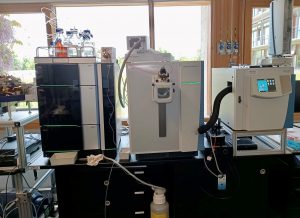
The Thermo Scientific™ Orbitrap Exploris™ 240 mass spectrometer provides the performance and versatility in a wide range of applications including small organic molecules, peptides, oligonucleotides and intact protein analyses. This instrument comes with the fast-scanning High-Field Orbitrap mass analyser, it is compatible with many next-generation ion sources but also the Triversa NanoMate® nanochip-based ESI as well as the FAIMS Pro™ interface.
Key points of this new FT-MS system are:
Ion sources:
- The instrument is delivered with the OptaMax™ NG ion source including an adjustable heated electrospray ionization (H-ESI II) probe for ultimate sensitivity
- The APCI and APPI probes can be easily installed for ionization of specific compound classes and interfacing with UPLC
- The new SICRIT® Ionization Source (Plasmion) combining ESI, APCI and APPI can be installed very quickly and easily for direct injection or interfacing the GC to FT-MS
.
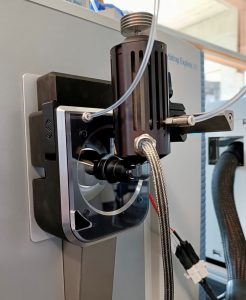
.
- The instrument is equipped with the Triversa NanoMatefor nanoflow chip-based infusion experiments offering very smooth ESI ionization conditions crucial for sensitive compounds.
- The Liquid Extraction Surface Analysis (LESA®) technology is available on the Triversa NanoMate, offering new techniques of HRMS surface analyses.
- The online gas-phase fractionation system FAIMS Pro (high field asymmetric ion mobility spectrometry) has been purchased for this Exploris 240. Based on differential ion mobility, this device increases the analytical selectivity and adds an additional fractionation step prior to MS while reducing time-consuming sample preparation.
- Polarity switching can be performed for any of the described Ion sources.
Orbitrap mass analyzer for FT-MS and MS/MS:
- The segmented quadrupole mass filter allows precursor ion selection with variable precursor isolation width from 0.4 to 1,200 Da and a MS/MS precursor ion selection with high transmission from m/z 40 to 2,500. The quadrupole mass range is extended to m/z 8000 with the BioPharma option for protein and large biomolecule analysis. Up to 20 precursors per scan can be selected for fragmentation, for multiplexing
- Reliable Automatic gain control (AGC) measurements for controlled injection of the number of ions is ensured by the novel Independent Charge Detector Orbitrap mass analyser
- The High-Field Orbitrap mass analyser with low noise detection pre-amplifier and a 4kV central electrode voltage
- The Exploris 240 delivers a resolution performance restricted to 240 k at m/z 200, which indeed might not be sufficient in some cases to resolve fine isotopic structures. To increase the resolving power of the instrument, the Booster® data acquisition system (Spectroswiss) is installed to the system. This device adds many advantages for example for the analysis of protein samples in particular for complex overlapping proteoform patterns, but also small molecule applications such as biofuel / biomass analysis.
Interchangeability of UPLC and GC for FT-MS coupling:
The extreme originality of our set-up is certainly the easy interchangeability between GC and UPLC separations prior to HRMS. This can be done thanks to the Sicrit® ionization source allowing direct coupling of GC to the Exploris 240 through a special heated transfer line (See Picture).
- UHPLC
The Thermo Scientific Vanquish Horizon UHPLC system provides high performance and throughput. With a fully biocompatible flowpath and ultra-low gradient delay volume, it offers superior separations with unsurpassed retention time and peak area precision, excellent detector sensitivity and lower baseline noise for the most demanding LC and LC-MS workflows. This system is equipped with high-pressure pumps (1200 bars) binary pumps with on-line solvent degasser, a column oven and a UV-visible detector.
.
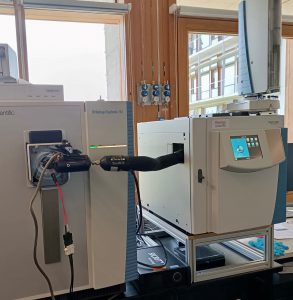
The Thermo Scientific™ TRACE™ 1300 Series Gas Chromatograph is the latest technology breakthrough conceived to substantially elevate performance in QA/QC and routine laboratories. The TRACE 1310 GC has an icon-driven touch-screen user interface ideal for direct instrument control in larger routine and method development laboratories. The column oven temperature ranges from 3 to 450°C. The split/splitless injector is suitable for all capillary columns (50 μm to 530 μm i.d.).
LTQ Orbitrap ELITE ETD (Thermo fisher)
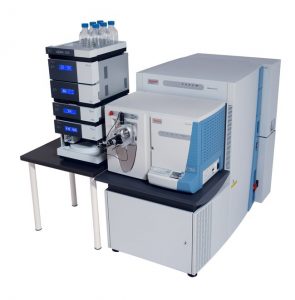
The Orbitrap Elite combines the high-field OrbitrapTM mass analyzer with the dual pressure linear ion trap and achieves routinely high resolution (>100,000) and high mass accuracy (∼2 ppm). It enables multiple fragmentation techniques such as CID, HCD and ETD. It is equipped with the standard ESI (H-ESI II) and the nanoESI (nanoSpray Flex Ion) sources, as well as the nanochiped-based ESI system Advion TriVera Nanomate®. It is interfaced with a nanoUPLC Ultimate 3000 system (Dionex) for LC-MS and LC-MSn experiments.
Orbitrap Q Exactive HF (Thermo Fisher)
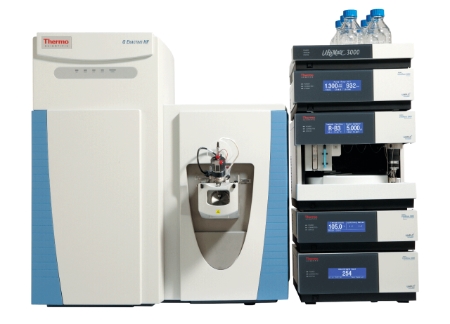
The Q Exactive HF system combines a segmented quadrupole for high-performance precursor ion selection with a high-resolution, accurate-mass (HR/AM) ultra-high-field Orbitrap mass analyzer. This instrument achieves routinely high resolution (>100,000) and high mass accuracy (∼2 ppm) with HCD fragmentation capabilities. It is equipped with the standard ESI (H-ESI II) source and interfaced with a UPLC Ultimate 3000 system (Dionex) for LC-MS and LC-MSn experiments. In addition, with the Protein Mode and BioPharma options as well as extended quadrupole mass range, this instrument is ideal for Native MS and Top-Down Proteomics experiments.
MALDI-TOF/TOF AutoFlex Speed (Bruker)
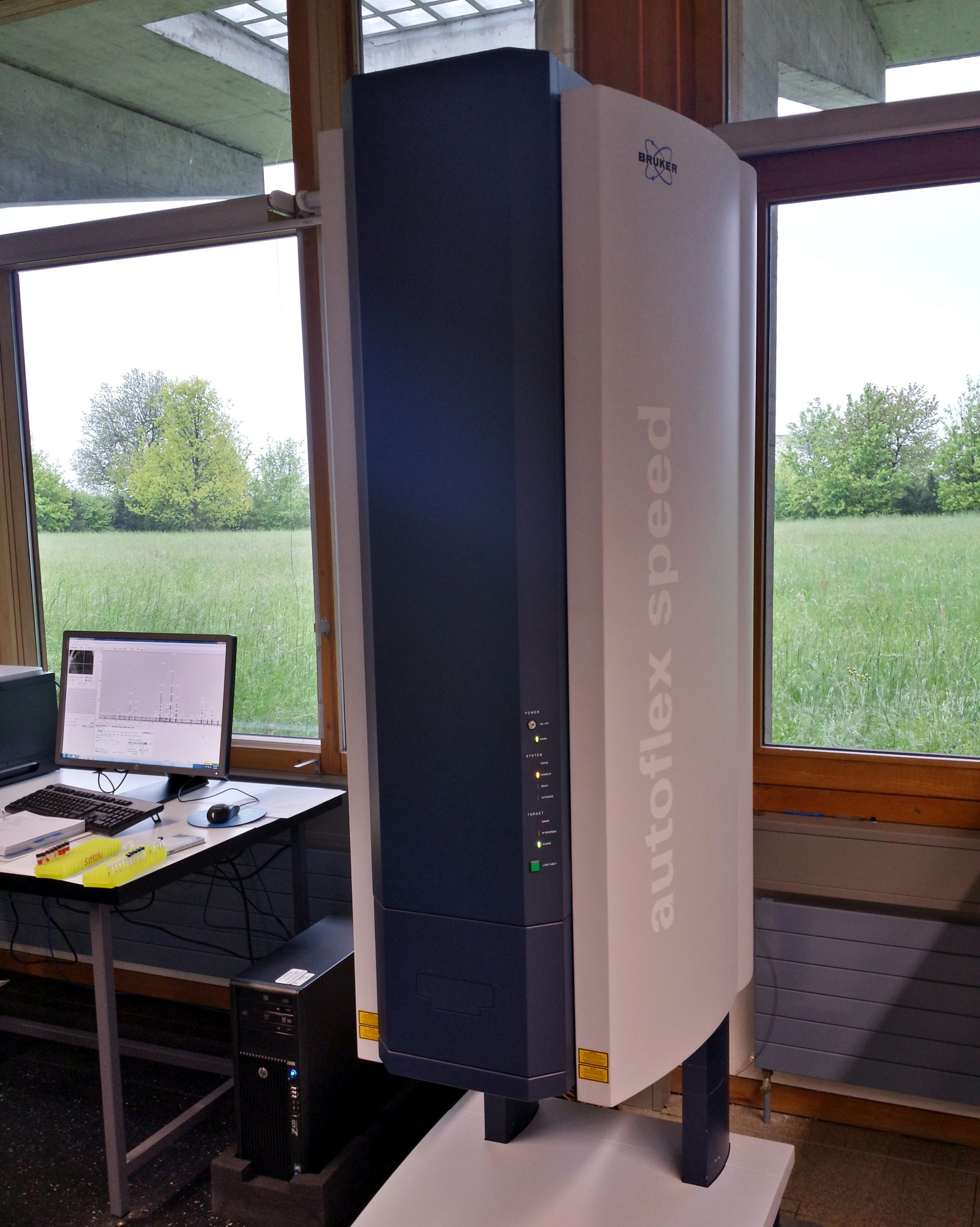
The MALDI-TOF AutoFlex speed has advanced performances for a broad range of applications. The instrument can be operated in reflector and linear modes (up to 100 kDa for intact proteins and large molecules such as polymers), as well as TOF/TOF tandem mass spectrometry. Its SmartbeamTM-II 2 kHtz laser and system electronics allow intensive and high throughput applications. This is an open-access instrument (training required) well suited for analysis of peptides and proteins, as well as small organic components, organometallics, nucleic acids, sugars and polymers.
Xevo G2-S QTOF (Waters)
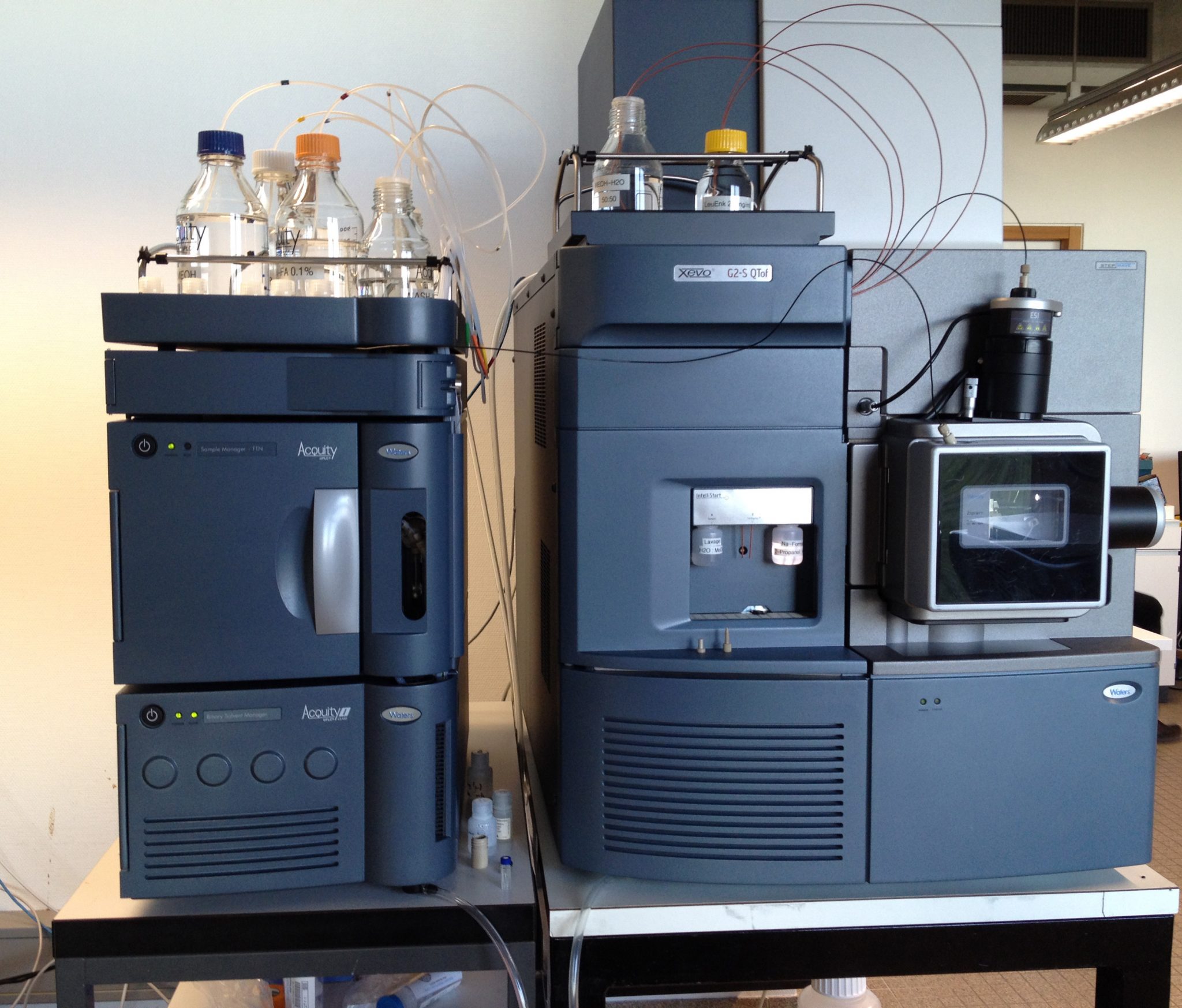
The Xevo® G2-S QTof is equipped with the StepWave™ ion optics to achieve high sensitivity levels and the QuanTof™ technology for high mass resolution, matrix-tolerant high dynamic range, quantitative performance, mass accuracy and speed of analysis. The mass analyzer is interfaced with Acquity UPLCpumps and sample manager systems. UPLC-MS and MS/MS can be acquired using the UPLC/MSE data acquisition or Fast Data Directed Analysis (FastDDA) modes, depending on the application. The instrument is equipped with the multi-ionization ESI-APCI source, as well as the APPI source.
VION IMS QTOF
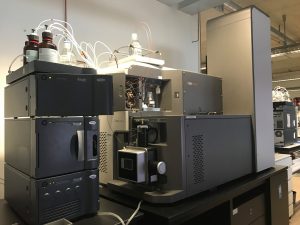
.
It delivers high resolution, high sensitivity, sub 1 ppm mass accuracy, and enhanced quantitative performance. Data acquisition methods use ion mobility as standard. Automatic data processing, data visualization and reporting are done using UNIFI®. Ion mobility cleans up and simplifies the spectra, enabling identification of all the compounds in the samples. With CCS values available for every ion in every analysis, new levels of confidence can be reached for identification. Identification based on CCS and <1 ppm mass accuracy is precise and independent of retention time.
Ion mobility:
Ion mobility separation not only allows chromatographically coeluting compounds to be resolved, but also structural isomers. Single component precursor/product ion spectra can be generated as ion mobility allows drift time and retention time alignment of product ion tp their respective precursors.
HDMSE fragmentation:
Every single analysis comes with data independent low and high energy collision induced dissociation, adding interesting structural information to accurate mass and CCS data.
6530 Accurate-Mass Q-TOF LC/MS (Agilent Technologies)
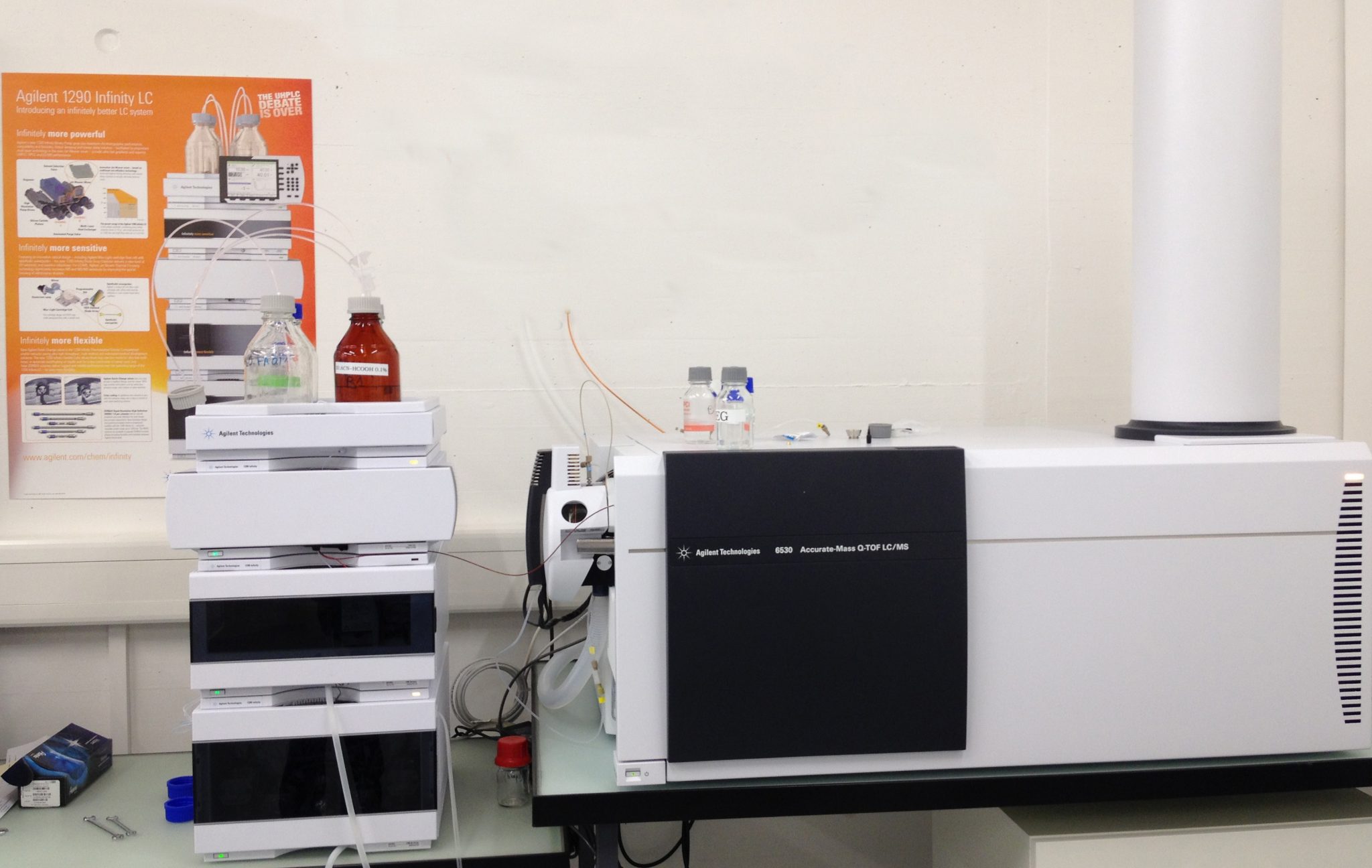
The 6530 Q-TOF incorporates the Agilent Jet Stream thermal gradient focusing technology, which dramatically improves the sensitivity. Its TOF technology delivers high mass accuracy (< 5ppm), resolution (20,000 not dependent on spectral acquisition rate) and dynamic range. It can be operated in a broad mass range mode (m/z 25 to 20,000). The instrument is interfaced with Agilent 1290 Infinite UHPLC modules and equipped with the Dual Jetstream ESI source.
LCQFleet (Thermo fisher)
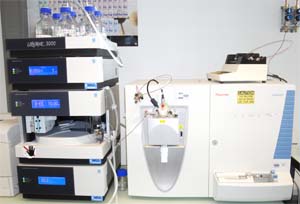
The LCQFleet Ion Trap mass spectrometer provides high sensitivity MS at fast cycle time measurements, and a fast positive/negative switching ionization mode. The instrument can be operated in Full-scan MS/MS mode, in Selected Reaction Monitoring (SRM) for quantitative experiments and MSn for multi-stage MS experiments to probe the structure of ions. The LCQFleet is equipped with the Ion Max-S API source and interfaced with a Dionex Ultimate 3000 UPLC system. This is an open-access instrument (training required).
TSQ8000 Triple Quadrupole GC-MS/MS (Thermo Fisher)
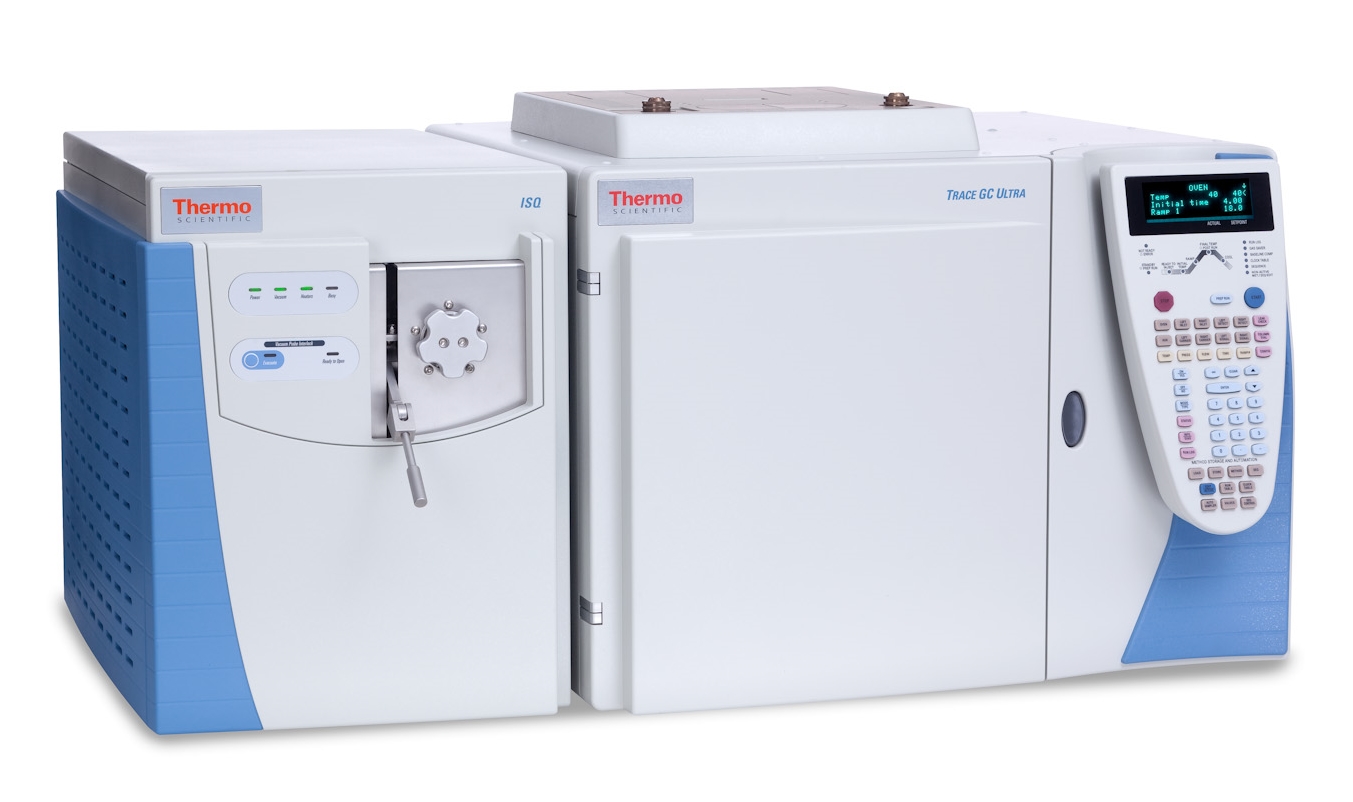
The TSQ8000 Triple Quadrupole GC-MS/MS instrument is paired with the Thermo scientific TRACE 1300 GC and the autosampler AI1310. The Triple quadrupole can work in Full scan, SIM, SRM and product ion-scan modes. It offers an extractable EI ion source with a vacuum probe interlock to remove entire source without venting. The mass range is 1.2-1200 m/z, and Electron Energy of the source is adjustable from 0 to 150 eV. Data are processed using XCalibur and TraceFinder Software for GC-MS quantification, as well as the NIST and MassFinder libraries for compound identification.
The TRACE 1300 GC is routinely equipped with a Capillary column VF-5ms suitable for a wide range of applications. The instrument is interfaced with the TriPlus RSH Autosampler for both liquid and Head-space injections.
ICP-MS NexIon 350 (Perkin Elmer)
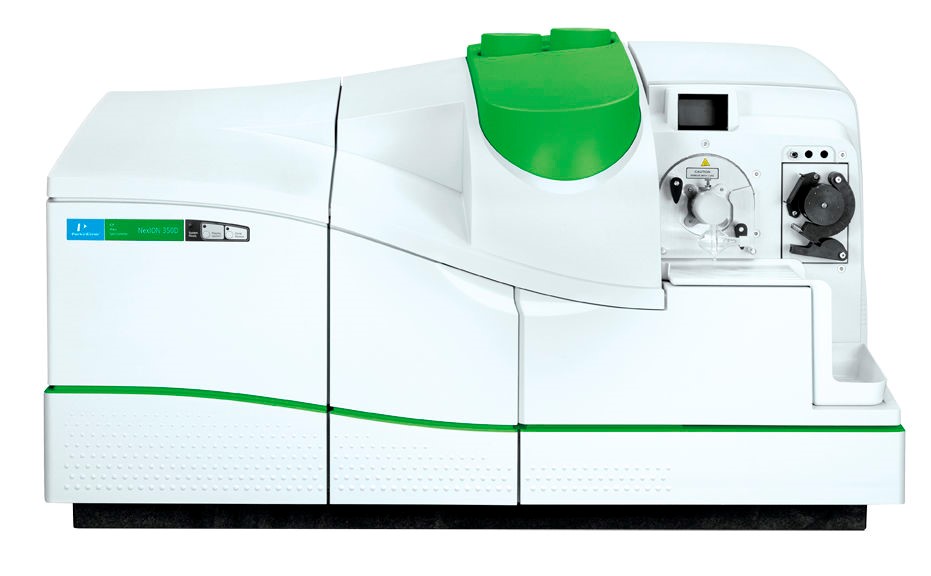
The NexION® 350D inductively coupled plasma mass spectrometer features a dual-channel Universal Cell and the Dynamic Reaction Cell™ technology, giving the flexibility to choose Kinetic Energy Discrimination (KED) and/or use a scanning quadrupole in the Dynamic Reaction Cell. The instrument provides enhanced sensitivity (down to low ppt level for certain metals) and allows both precise quantitative and semiquantitative (screening mode) analysis of various metals.